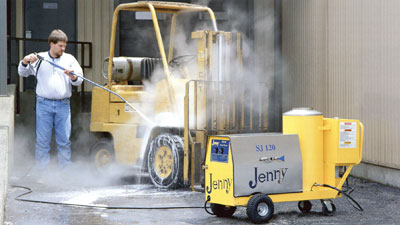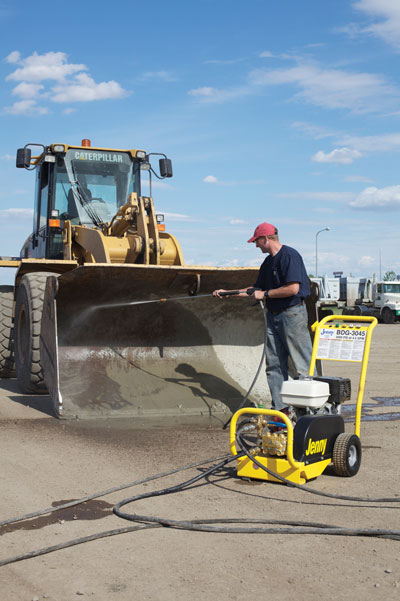
Coming clean
By Daniel Leiss president of Jenny Products
Features Tech tipsMany view cleaning as a simple process. We wash, wipe and scrub every day without giving it too much thought.
Many view cleaning as a simple process. We wash, wipe and scrub every day without giving it too much thought. But what if the job is more complex than a simple scrub down? While basic cleaning is almost an automatic process, tough cleaning jobs require more thought and even some problem-solving tactics.
 |
|
| Using heat and pressure on greasy messes can be a mistake as the heavy water flow may simply spread the contaminant around and create a film. Grease and oil are best tackled with steam cleaners.
|
There are several products available to assist in cleaning efforts. While this can be great for your rental operation in the sense that it will allow you to provide many helpful options to assist a customer’s cleaning efforts, it can also be overwhelming for the customer to choose the right one. It is up to you to have the knowledge and expertise to recommend the best solution for each individual problem, likely resulting in a happier, repeat customer.
Digging up the facts
First, you need to know a few details about the customer, including what he or she hopes to achieve by cleaning and what type of contaminant is involved. Common contaminants include those that can be seen, such as dirt and grease, and those that cannot be seen like bacteria and germs. Knowing these facts will dictate whether the customer needs something that will provide a quick rinse or a machine that will kill germs and sanitize as well. And because different cleaners provide faster results than others, it is also wise to find out how much time the customer wants to spend cleaning.
The next step is taking these facts and thinking about the combination of elements that will best solve the problem. There are four basic elements of cleaning: flow, chemical, temperature and pressure. Changing one element, even slightly, significantly affects the other three. Not only that, but any deficiency in one element can be made up by a stronger presence of another. When the elements are thoroughly understood, you will be able to apply this knowledge to complex cleaning problems and come up with the best solution.
Dynamics of the elements
The best way to introduce the four elements is to visualize a basic cleaning task. Think about someone washing dirt off his hands. The cold water from the faucet (flow) combined with rubbing his hands together (pressure) would be sufficient enough to remove the dirt, but would not provide a thorough cleaning. In order to accomplish this, adding some soap (chemical) and warmer water (temperature) would be effective and also speeds up the process.
 |
|
| High-pressure, hot water solutions are best for blasting heavy mud and grime off heavy equipment.
|
Seems simple enough right? But what if instead of dirt, the person’s hands are covered in a greasy deposit? In this case, flow, pressure, chemical and a cold temperature of water would not be enough to provide a thorough cleaning, as cold water does not effectively remove grease. To clean away grease, hot water combined with the other elements is required.
Now let’s take this hand-washing example and change it a bit to illustrate the fact that any deficiency in one element can be made up by more effort from another. Imagine the person’s hands are not covered in light dirt or grease – this time they are caked with mud. The presence of all four elements would be necessary to efficiently clean the mud off.
But what if hot water isn’t available? Her hands can still be cleaned thoroughly, but not without a little more effort from the other elements. Maybe using a stronger soap or scrubbing her hands together more briskly to create additional pressure would be enough to make up for the low temperature. Both of these would be effective ways for the other elements to work harder and compensate for the lack of one. Conversely, if a weak chemical were being used, added pressure and the use of hotter water would make up for the deficiency.
The hand-washing example is not hard to grasp. But what this example does is break down the cleaning process so it can be understood and applied to complicated, real-life situations.
Ready, set – clean!
Combination cleaners consist of both a cold and hot pressure washer as well as a steam cleaner in one portable package.
Because they offer the option to quickly switch between the three functions, the two biggest features they offer are convenience and versatility. They save the user time, as well as spare them the need to rent multiple machines.
While versatility is the main selling point of these machines, it can also be overkill for the customer. They may see the machine as a time-saver and an opportunity to have one cleaner that can do it all, but in reality they may not need all three uses, resulting in wasted functionality. So, again, be sure to clarify each customer’s intentions before simply renting a catch-all solution. Though it takes a little extra time, renting a more catered solution helps build stronger, longer-term relationships with customers.
People clean to achieve a variety of results. Whether they are prepping surfaces for painting, killing germs and sanitizing, or simply cleaning for appearances’ sake, it is important to remember that there will always be one combination of the basic cleaning elements that produces the best results. Armed with this knowledge, you’ll now be able to better analyze customers’ challenges and provide them with the proper tools and information to make the best cleaning decision.
Print this page
Leave a Reply